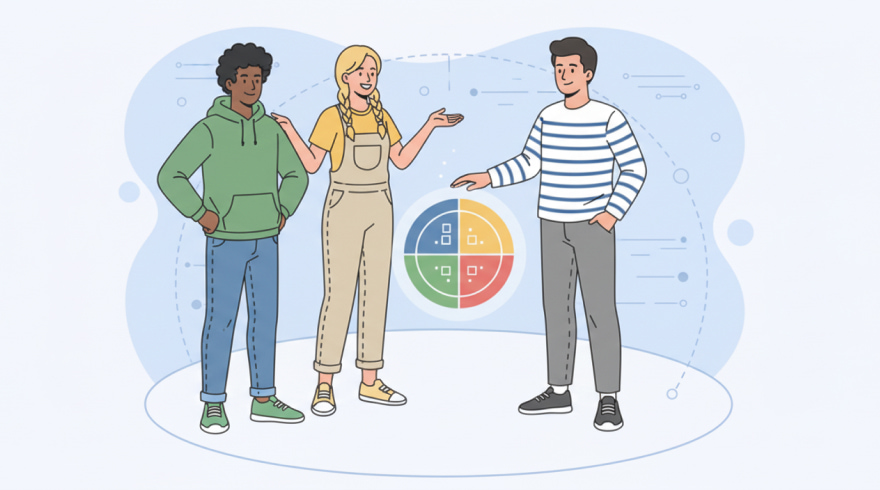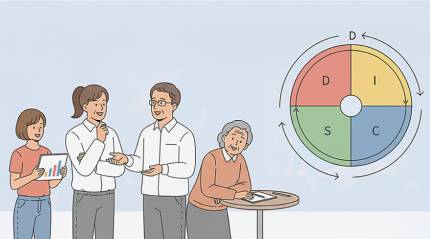Complete Guide to the DISC Model: Practical Insights and Real-World Application
- 12 October 2025

The DISC model offers a clear lens for interpreting everyday behavior, blending observable tendencies with situational context to reveal how people communicate, make decisions, and respond to pressure. Rooted in behavioral science, this framework segments tendencies into four broad styles, helping readers decode patterns without resorting to stereotypes. Rather than labeling people, the approach highlights preferences, stress responses, and situational adjustments that can be trained, coached, and refined over time.
In everyday use, the DISC assessment meaning connects traits with predictable patterns across communication and decision-making. Practitioners value the model because it gives a shared language for feedback, which accelerates coaching conversations and reduces friction in cross-functional work. Teams DISCover why certain meetings drag, why a manager’s feedback lands poorly, or why a sales call stalls, and they gain a roadmap for adapting responses. When a shared vocabulary replaces guesswork, people can align without compromising individuality or creativity.
Many newcomers wonder how a short behavioral instrument can produce actionable clarity without oversimplifying personality. In practice, the DISC assessment explained narrative emphasizes that the tool describes behavior, not ability, enabling practical adjustments in tone, pacing, and delegation. Organizations appreciate the way the model scales from onboarding to executive coaching, maintaining relevance in daily routines. That consistency means the insights don’t gather dust; they guide email phrasing, meeting agendas, conflict resolution, and even customer service scripts that resonate with different preferences.
- Gives a common language for feedback that reduces friction.
- Focuses on observable behavior, not fixed traits or labels.
- Translates quickly into coaching plans and role-specific playbooks.
- Adapts to hiring, sales enablement, leadership development, and onboarding.
How the Framework Works in Practice
In real work environments, the model reveals why certain tasks energize one person and drain another, and it helps teams slot strengths where they create the most value. Coaching becomes sharper when leaders know which signals encourage collaboration and which signals raise defensiveness. Many facilitators visualize the four styles and their blends on a circular map to show relational proximity and tension points across styles.
For quick orientation, many professionals reference the DISC assessment wheel during debriefs because a circular map makes social dynamics easier to grasp. The map clarifies how assertiveness, pace, and preference for structure shape interactions, and it keeps DISCussions concrete rather than abstract. You can use the map as a living artifact in 1:1s, retrospectives, and pipeline reviews to keep adjustments visible and measurable.
| Work Style Focus | Strengths You’ll Notice | Watch-outs Under Stress | Best Coaching Moves |
|---|---|---|---|
| Decisive, outcome-driven tasks | Bold calls, swift prioritization | Impatience, blunt delivery | Define success criteria and autonomy |
| Social, collaborative initiatives | Enthusiasm, momentum building | Overpromising, distraction | Set milestones and narrative clarity |
| Support, service, and stability | Consistency, loyalty, listening | Reluctance to change, avoidance | Offer preparation time and reassurance |
| Quality, analysis, and precision | Accuracy, risk mitigation | Overanalysis, rigidity | Provide data, standards, and rationale |
When teams use blended style data to clarify role expectations, the insights become tactical rather than theoretical. A focused debrief after a DISC profile assessment often yields specific agreements on handoffs, meeting formats, and decision rights. The clarity improves sprint planning, customer DISCovery interviews, and cross-team alignment because preferences are respected without sacrificing speed. Over time, these micro-adjustments reduce burnout and increase throughput as people work how they work best.
Personal Growth: Turning Insight Into Daily Habits
Self-awareness accelerates when individuals translate patterns into micro-habits that stick under pressure. A common mistake is treating results as a static label rather than a dynamic set of tendencies that can flex with training. Coaches encourage clients to pick a single context, like weekly one-on-ones, and experiment with small shifts in tone, timing, or documentation to observe behavioral impact.
For many people, a guided debrief after a DISC personality assessment produces momentum because it links strengths to specific routines, not vague platitudes. A participant might decide to slow their cadence in status updates, ask two clarifying questions before proposing a fix, or provide concise rationale for a recommendation. Small, repeatable changes enable growth without cognitive overload, which is why habit stacking works so well with behavioral insights.
Progress compounds further when you reflect on patterns across different contexts, such as conflict, delegation, and brainstorming. In many cases, a clear reading of your DISC assessment profile makes it easier to choose the right preparation tactic before a high-stakes conversation. If you know that data concision boosts your influence with a precise colleague, you can design your message to hit their priorities on the first pass. Over weeks, this cycle of anticipate, adapt, and review turns self-knowledge into measurable outcomes.
- Pick one routine and test a single behavioral tweak.
- Journal what worked, what backfired, and why.
- Ask a trusted partner to observe your adjustments.
- Scale the winning behaviors into team norms.
Leadership and Teams: From Insight to Organizational Impact
High-performing leaders turn behavioral insight into operating rhythm, weaving it into agendas, decision frameworks, and coaching cadences. The result is a culture where people know what “good” looks like in meetings, emails, and handoffs, which lowers friction and accelerates delivery. Managers also learn which feedback prompts unlock growth for different styles, avoiding generic advice that rarely moves the needle.
Programs that incorporate a targeted DISC leadership assessment often raise the quality of delegation, because managers understand both the pace and structure that their direct reports prefer. When leaders calibrate communication to match motivation, projects run smoother and fewer issues escalate. This translates into faster cycle times, less rework, and clearer ownership, especially in cross-functional initiatives where misalignment silently burns hours.
At the team level, a shared framework empowers people to request clarity without sounding confrontational. Many organizations find that a simple primer on DISC assessment reduces unproductive conflict and increases psychological safety. By setting norms that respect diverse working preferences, leaders demonstrate care while preserving accountability. Over time, this combination strengthens trust and improves retention because people feel seen, supported, and challenged appropriately.
- Embed behavioral norms in onboarding and manager training.
- Use meeting templates that honor pacing and information needs.
- Create coaching prompts for each style to improve feedback quality.
- Review norms quarterly to keep them relevant as teams evolve.
Testing and Access Options: Choosing the Right Path
Organizations and individuals have many routes for getting started, ranging from lightweight questionnaires to robust platforms with analytics and team overlays. The best choice depends on your goals: hiring validation needs rigor, while coaching may prioritize clarity and shared language. Before investing, consider data privacy, reporting depth, facilitator support, and integration with your existing learning stack.
Some teams begin with a straightforward DISC assessment test to capture baseline tendencies for a project launch or workshop. That approach seeds a common language quickly, making it easier to agree on meeting structures, role expectations, and communication norms. As momentum builds, leaders often graduate to versions that include team maps, comparison reports, and action guides.
Companies exploring inclusive access sometimes pilot a tool that is DISC assessment online for free to gauge interest and fit before rolling out a full program. While free options can introduce the vocabulary and spark curiosity, robust initiatives typically require validated instruments and structured debriefs. A phased rollout also helps budget owners link investment to measurable outcomes like reduced churn, faster onboarding, and higher sales conversion.
- Define outcomes first: hiring, coaching, sales enablement, or conflict reduction.
- Match tool complexity to the decision you need to make.
- Ensure reporting is understandable for non-experts.
- Align coaching resources to sustain behavior change.
Budget-Friendly Approaches and Ethical Use
Scaling behavioral literacy doesn’t have to drain budgets, especially when you start with clear goals and focused pilots. Ethical use matters as much as instrument selection, which means keeping results confidential, avoiding labels that limit people, and anchoring DISCussions in real work. With those guardrails, even small teams can create repeatable practices that improve collaboration and performance.
Teams testing the waters often begin with resources that are DISC assessment for free to build a baseline understanding before funding comprehensive programs. Early exposure gives everyone a taste of the vocabulary and the kinds of adjustments that create smoother interactions. After a brief trial period, it’s easier to justify investment in deeper reporting, facilitator time, and follow-up coaching.
For pilot cohorts, a limited-run option that is DISC assessment test for free can provide sufficient data to guide norms, meeting structures, and conflict protocols. As soon as the stakes rise, such as hiring or high-risk role assignments, leaders should shift to validated tools with structured debriefs and governance. That balance keeps exploration cost-effective while ensuring rigor where decisions have lasting consequences.
- Protect privacy and use results for development, not exclusion.
- Train managers to interpret results responsibly and avoid bias.
- Pair insights with measurable habit experiments to track impact.
- Reassess tools annually to maintain validity and relevance.
FAQ: Your Top Questions Answered
- How accurate is a behavioral instrument like DISC?
Accuracy depends on instrument quality, clarity of questions, and how results are interpreted. Reliable versions use consistent scoring, transparent constructs, and clear documentation. Results are most useful when paired with a structured debrief and practical behavior experiments that test insights in real scenarios.
- Is it a personality test or a behavioral model?
DISC describes observable behavior and preferences rather than deep personality traits. It focuses on how you tend to communicate, make decisions, and respond under stress, which can shift across contexts and develop with practice.
- Can teams use results for hiring decisions?
While insights can inform interviews and onboarding, hiring should never rely solely on a single tool. Organizations should use validated methods, multiple data points, and clear job criteria to avoid bias and ensure fairness.
- How often should results be revisited?
Revisit insights during major role changes, after new managers join, or when team norms shift. A periodic review, quarterly or biannually, keeps agreements current and supports continuous improvement in communication and collaboration.
- What’s the best way to turn insight into action?
Start with one routine, define a small behavior to try, and gather feedback. Document what changes worked, iterate on the next experiment, and scale habits that improve outcomes. Consistency beats intensity when building durable communication skills.



